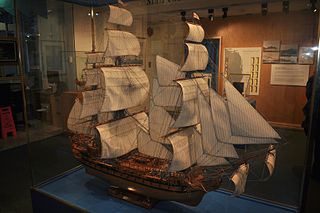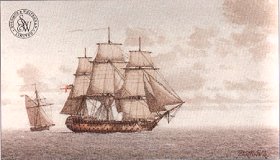
HMS Agincourt was a 64-gun third-rate ship of the line of the Royal Navy, launched on 23 July 1796 at Blackwall Yard, London. The Admiralty bought her on the stocks from the East India Company in 1796, who had called her Earl Talbot.

HMS Albion was a 74-gun third-rate ship of the line of the Royal Navy. She was launched at Perry's Blackwall Yard on the Thames on 17 June 1802. She was broken up at Chatham Dockyard in 1836.

HMS Orion was a 74-gun third rate ship of the line of the British Royal Navy, launched at Deptford on 1 June 1787 to the design of the Canada class, by William Bately. She took part in all the major actions of the French Revolutionary and Napoleonic Wars under a series of distinguished captains.

HMS Magnanime was a 64-gun third-rate ship of the line of the Royal Navy, launched on 14 October 1780 at Deptford Dockyard. She belonged to the Intrepid class designed by Sir John Williams and later was razeed into a 44 gun frigate.

HMS Edgar was a 74-gun third-rate ship of the line of the Royal Navy, that saw service in the American Revolutionary, French Revolutionary and Napoleonic Wars. Launched in 1779, she fought in the battles of Cape St Vincent and Copenhagen, two of the major naval engagements of the wars.

HMS Excellent was a 74-gun third-rate ship of the line of the Royal Navy, launched at Harwich on 27 November 1787. She was the captaincy of John Gell before he was appointed an Admiral.

HMS London was a 90-gun second-rate ship of the line of the Royal Navy, launched on 24 May 1766 at Chatham Dockyard.

HMS Triumph was a 74-gun third-rate ship of the line of the Royal Navy, launched on 3 March 1764 at Woolwich.
HMS Russell was a 74-gun third rate ship of the line of the Royal Navy, launched on 10 November 1764 at Deptford.

HMS St Albans was a 64-gun third rate ship of the line of the Royal Navy, launched on 12 September 1764 by Perry, Wells & Green at their Blackwall Yard, London.
HMS Stately was a 64-gun third-rate ship of the line of the Royal Navy, launched on 27 December 1784 at Northam.

HMS Hector was a 74-gun third rate ship of the line of the Royal Navy, launched on 27 May 1774 at Deptford.

HMS Diadem was a 64-gun third rate ship of the line of the Royal Navy, launched on 19 December 1782 at Chatham. She participated in the Battle of Cape St Vincent in 1797 under Captain George Henry Towry.
HMS Kent was a 74-gun third-rate ship of the line of the Royal Navy, launched on 17 January 1798 at Blackwall Yard.

HMS Dragon was a 74-gun third rate ship of the line of the Royal Navy, launched on 2 April 1798 at Rotherhithe. She was designed by Sir William Rule, and was the only ship built to her draught.

HMS Eagle was a 74-gun third rate ship of the line of the Royal Navy, launched on 27 February 1804 at Northfleet.

HMS Monmouth was a 64-gun third rate ship of the line of the Royal Navy, launched on 23 April 1796 at Rotherhithe. She had been designed and laid down for the East India Company, but the Navy purchased her after the start of the French Revolutionary War. She served at the Battle of Camperdown and during the Napoleonic Wars. Hulked in 1815, she was broken up in 1834.
HMS Lancaster was a 64-gun third-rate ship of the line of the Royal Navy, launched on 29 January 1797 at Rotherhithe. She was designed and built as the East Indiaman Pigot for the British East India Company, but the Navy purchased her on the stocks because of a shortage of naval vessels to prosecute the French Revolutionary Wars.

HMS Rodney was a two-deck 90-gun second-rate ship of the line of the Royal Navy. Launched in 1833, she was broken up in 1884.

Bienfaisant was a 64-gun ship of the line of the French Navy, launched in 1754.
















